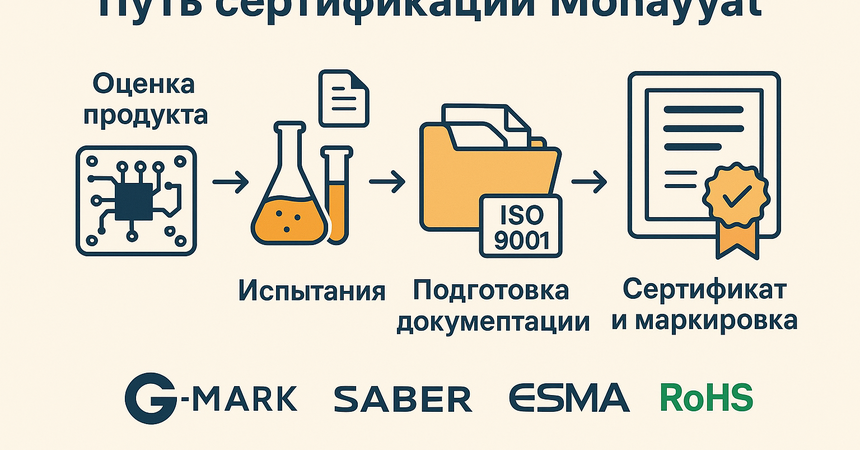MOIAT Certification: Everything You Need to Know About Electrical Equipment Compliance in the MENA Region
Meta description: Detailed guide on MOIAT Certification for electrical equipment exports to the Middle East and North Africa. Learn what products require it, how the certification process works, and how Worldwide Bridge provides turnkey compliance support.
1. What Is Mohayyat Certification and Why Does It Matter?
Mohayyat Certification is a conformity assessment procedure required for electrical products entering specific countries in the Middle East and North Africa (MENA), such as Saudi Arabia, the United Arab Emirates (UAE), Kuwait, Qatar, Bahrain, Oman, and others.This certification confirms that a product complies with the technical regulations, safety standards, and national conformity requirements of the destination country.
It typically covers:
- Electrical safety (risk of fire, shock, short circuit);
- Electromagnetic compatibility (EMC) (non-interference with other devices);
- Energy efficiency (based on national and GCC energy performance benchmarks);
- Hazardous substances restriction (similar to RoHS standards).
In some jurisdictions, "Mohayyat Certification" refers to a general term encompassing multiple national schemes such as SABER (Saudi Arabia), G-Mark (Gulf states), ESMA (UAE), and others. Each scheme may have its own technical and procedural specifics, but the end goal remains: proving safety, quality, and compliance.
2. Which Products Require MOIAT Certification?
Certification requirements vary by country, but in general, the following categories of electrical and electronic equipment require Mohayyat or equivalent conformity:Low-voltage electrical equipment
- Switches, sockets, circuit breakers;
- Extension cords, surge protectors;
- Fuse boxes and consumer units.
- LED lamps and luminaires (indoor/outdoor);
- Commercial and industrial lighting systems;
- Emergency lighting and safety exit lights.
- Distribution panels, control cabinets;
- Industrial transformers and switchgear;
- Smart grid components, programmable controllers.
- Air conditioners, refrigerators, microwaves;
- Washing machines, dryers, electric ovens;
- Water heaters, kettles, vacuum cleaners.
- Components and accessories
- Connectors, relays, timers;
- Cables, wiring harnesses;
- IoT-enabled smart home devices.
3. How the MOIAT Certification Process Works — Step by Step
Obtaining Mohayyat Certification (or its national equivalent) involves a multi-stage compliance workflow. Each step must be carefully executed to avoid customs delays or rejections.Step 1: Product Evaluation & Standards Identification
Certification experts analyze the product specifications and determine which technical standards apply:
- IEC 60335, IEC 60598, etc. — international electrical safety;
- SASO standards (Saudi Arabia);
- ESMA standards (UAE);
- GSO & G-Mark for the Gulf Cooperation Council region;
- RoHS compliance, where applicable.
Step 2: Laboratory Testing in Accredited Facilities
Testing is conducted by ISO/IEC 17025-accredited labs, either within the target country or internationally (if accepted).Tests may include:
- Electrical strength and insulation resistance;
- EMC emissions and immunity performance;
- Thermal behavior under load;
- Ingress protection (IP rating);
- Hazardous material content (lead, mercury, cadmium, etc.);
- Energy efficiency benchmarks (for appliances and lighting).
Step 3: Technical Documentation & File Preparation
A Technical Construction File (TCF) must be compiled. It typically includes:- Product description and specifications;
- Circuit diagrams and part lists;
- Safety instructions and labeling details;
- User manual in Arabic or bilingual (depending on country);
- Test reports and factory audit results;
- Manufacturer’s ISO 9001 certificate (recommended or required).
Step 4: Submission, Review & Certificate Issuance
The full set of documents is submitted to the authorized conformity assessment body (CAB) in the destination country.After document review and successful evaluation:
- A Mohayyat Certificate or a local conformity mark (such as G-Mark, ESMA CoC, or SABER certificate) is issued.
- The product is registered for customs and market release.
- The product label must include applicable compliance marks (e.g., SASO mark, G-Mark logo, energy efficiency label).
4. Why Worldwide Bridge Is Your Strategic Compliance Partner
Exporting electrical products to the MENA region requires more than translation or routine testing — it requires deep knowledge of regulatory systems, technical standards, and legal nuances in each target country.At Worldwide Bridge, we provide end-to-end Mohayyat certification services and related compliance solutions tailored to your product and market.
With us, you get:
- Expert regulatory analysis for the specific country and product type;
- Lab coordination with authorized facilities (in-country and international);
- Preparation of full technical documentation and translations;
- Submission and monitoring with certification authorities;
- Final certificate delivery, label design, and after-support.
Whether you're targeting Riyadh, Dubai, Doha, or Muscat — we manage the process from start to finish.
Contact Worldwide Bridge today — and let’s bring your electrical equipment to the Middle East the smart way: tested, certified, and ready for success.
